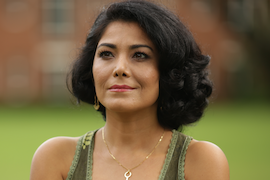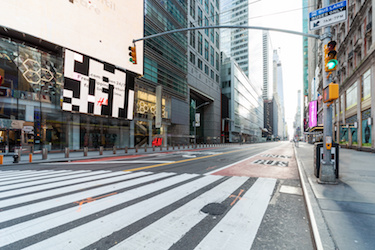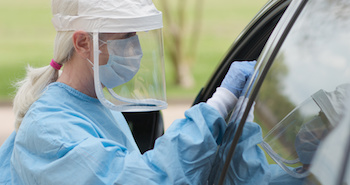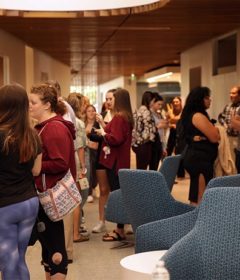‘Trust Science’


Asal Mohamadi Johnson, PhD, doesn’t have to tell anyone about the pains of the novel coronavirus pandemic. One only needs to look outside or watch a media report. It’s horrifying.
Also, there is no need for Johnson, assistant professor of public health in Stetson’s Department of Environmental Sciences and Studies, to discuss the necessities of handwashing or social distancing. Those requirements have been relayed and replayed again and again during the past numerous weeks.
However, Johnson — scientist, researcher and professor — does have a message to all, especially her students: Learn from this.
“This is an opportunity for us to learn from this experience for next time humanity is attacked by a force of nature. We know that emerging pathogens have been serious threats and continue invading us. Let’s hope we learn important lessons from this pandemic,” asserted Johnson, who arrived at Stetson in 2014.
Emerging infections, explained Johnson, are new infections where human populations have low or no immunity against them. Johnson pointed to the previous introductions of HIV, first reported in early 1980s and declared a pandemic in 2006, and Ebola, which brought global crises in 2014, and the initial responses to them.

Based on previous national and international responses, this time, though, the chance was missed, Johnson said.
“The COVID-19 could be a potential for us to practice good epidemiology and public health at national and local levels and display the power of science and evidence-based decision making in encountering a new virus. Unfortunately, we lost that opportunity by denying the threat existed,” she said. “We will now have to spend trillions of dollars in saving our economy in addition to making investments in vaccine and pharmaceutical trials. I do not find the direction we are heading exciting [at the moment]. However, this virus is showing us our weaknesses and what is not working in our health care systems. It shows us what happens when we sideline science.”
Nonetheless, Johnson still sees opportunity. Johnson is a published author on several research topics, including the prevalence and survival benefit of adjuvant chemotherapy, as well as the neighborhood characteristics on patient surgery and survival, which encompassed factors like segregation and economic deprivation. She would relish her own opportunity to explore COVID-19.

“I believe it will be valuable research to compare case-fatality ratios of different countries, controlling for different factors such as population demographics, prevalence of underlying conditions, levels of developments, prevalence of smoking and populations density, and see which type of health care system and approach experienced lower case-fatality,” she said. “As of now, there are many questions and hypotheses when comparing the crude numbers. But until we have enough evidence to study this retrospectively, we will not be able test our hypotheses.
“My general theme of research is focused on epidemiology of inequality. In combating COVID-19, we have to heavily rely on medical equipment and resources. I am concerned that resource-poor countries will have a disproportionate share of fatality because they lack resources necessary to save peoples’ lives.”
Greater research remains needed, she affirmed. There are lessons to be learned.
“Every semester, I spend a good portion of my global health and epidemiology classes teaching students about the challenges of controlling infectious diseases. My students are now living what we have always been discussing,” Johnson said. “I want them to see and know how relevant infectious disease is.
“The horror of infectious disease is not a thing of the past, and not a problem of less-developed countries. This is not about the problem of ‘others.’ Infectious disease is powerfully present in our world to show us the interconnectedness among humanity. It demonstrates the impacts of reckless interactions among environment, humans and pathogens, and why we need regulations to protect humans and the environment from such destructive interplays.
“I hope my students exercise their critical thinking and are able to see that bacteria and viruses do not show any preference based on people’s nationality and passport,” she continued. “The same way HIV did not have any preference for people’s sexual orientation. I would like for my students to see how public health fails when policy makers marginalize science and evidence.”
The science of public health, Johnson concluded, makes a difference.
“Public health works and saves lives when those in power and the majority of people trust science. It is science, not walls, that can stop the spread of diseases,” she said.
“Public health is a much-needed field regardless of countries’ level of development. Infectious disease control and prevention remain a critical area of public health globally, nationally and locally. Public health and biomedical sciences are intertwined and inseparable.”
-Michael Candelaria

Understanding Control and Prevention
In the case of controlling and preventing an infectious disease, such as COVID-19, Asal Mohamadi Johnson, PhD, explained the multilayered approach being taken worldwide.
According to Johnson, there are three levels of prevention in public health: primary, secondary and tertiary. Primary prevention is about preventing the disease. Basic hygiene practices, physical distancing and staying home, such as being done now, are primary preventions. In turn, testing who has the disease and isolating them, contact tracing and identifying the exposed people, and quarantining them are critical secondary preventions, as is being done now. Then tertiary prevention — taking better care of those who experience serious illness and need hospitalization.
“In other words, primary and secondary prevention could buy us some time that can be spent on better quality of care and finding better treatments for those who are critically ill,” Johnson said. “COVID-19 is showing us the three levels of preventions are interconnected and necessary all together. Only focusing on one will not work.”



